Tesco's Globalization: Drivers for Expansion and Exit in South Korea
VerifiedAdded on 2020/04/21
|9
|2910
|246
Report
AI Summary
This report examines Tesco's globalization strategy, specifically its expansion into and subsequent exit from the South Korean market. It identifies and analyzes the key drivers of globalization that influenced Tesco's decisions, including cost, market, government, and competitive factors. The report explores how these drivers impacted Tesco's operations, growth strategies (such as store layout, supply chain management, joint ventures, and brand positioning), and ultimately, its decision to leave the market. The analysis considers the economic and regulatory changes in South Korea that led to Tesco's challenges and eventual exit, providing insights into the complexities of international business and the impact of globalization on retail companies. The report highlights the strategies Tesco employed to maintain growth, as well as the external factors that ultimately led to their departure from South Korea, offering a comprehensive overview of Tesco's experience in this international market.
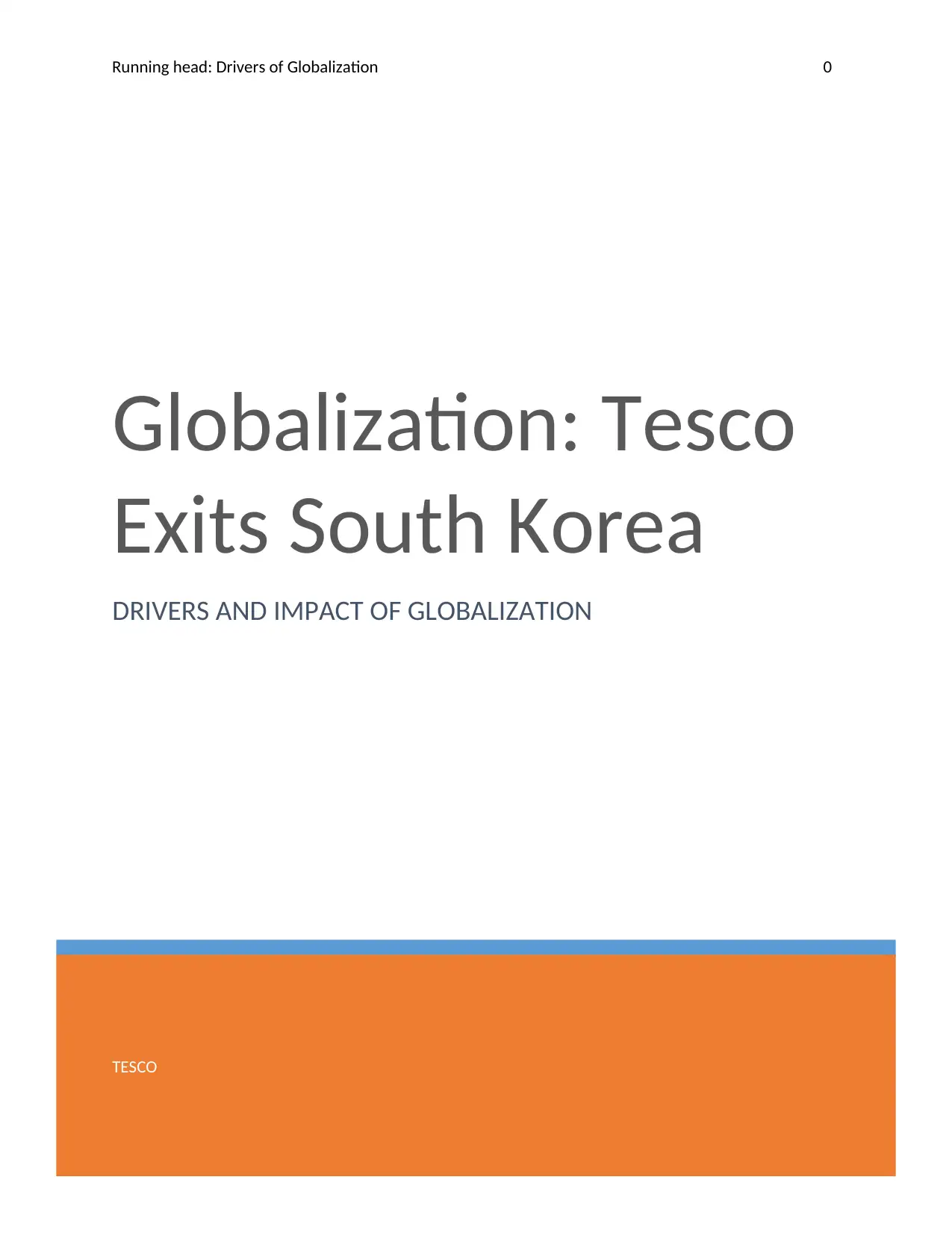
TESCO
Globalization: Tesco
Exits South Korea
DRIVERS AND IMPACT OF GLOBALIZATION
Running head: Drivers of Globalization 0
Globalization: Tesco
Exits South Korea
DRIVERS AND IMPACT OF GLOBALIZATION
Running head: Drivers of Globalization 0
Paraphrase This Document
Need a fresh take? Get an instant paraphrase of this document with our AI Paraphraser
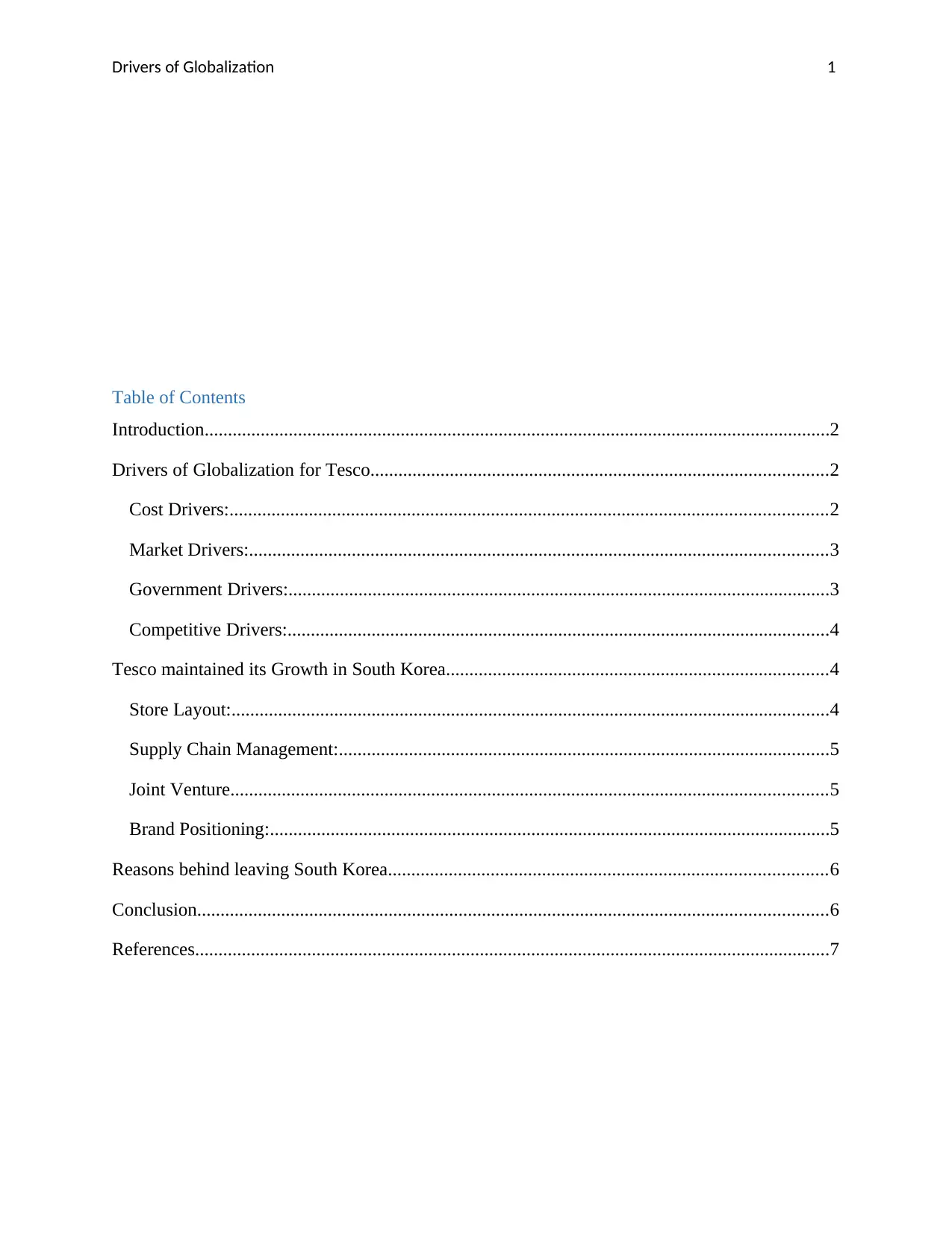
Drivers of Globalization 1
Table of Contents
Introduction......................................................................................................................................2
Drivers of Globalization for Tesco..................................................................................................2
Cost Drivers:................................................................................................................................2
Market Drivers:............................................................................................................................3
Government Drivers:....................................................................................................................3
Competitive Drivers:....................................................................................................................4
Tesco maintained its Growth in South Korea..................................................................................4
Store Layout:................................................................................................................................4
Supply Chain Management:.........................................................................................................5
Joint Venture................................................................................................................................5
Brand Positioning:........................................................................................................................5
Reasons behind leaving South Korea..............................................................................................6
Conclusion.......................................................................................................................................6
References........................................................................................................................................7
Table of Contents
Introduction......................................................................................................................................2
Drivers of Globalization for Tesco..................................................................................................2
Cost Drivers:................................................................................................................................2
Market Drivers:............................................................................................................................3
Government Drivers:....................................................................................................................3
Competitive Drivers:....................................................................................................................4
Tesco maintained its Growth in South Korea..................................................................................4
Store Layout:................................................................................................................................4
Supply Chain Management:.........................................................................................................5
Joint Venture................................................................................................................................5
Brand Positioning:........................................................................................................................5
Reasons behind leaving South Korea..............................................................................................6
Conclusion.......................................................................................................................................6
References........................................................................................................................................7
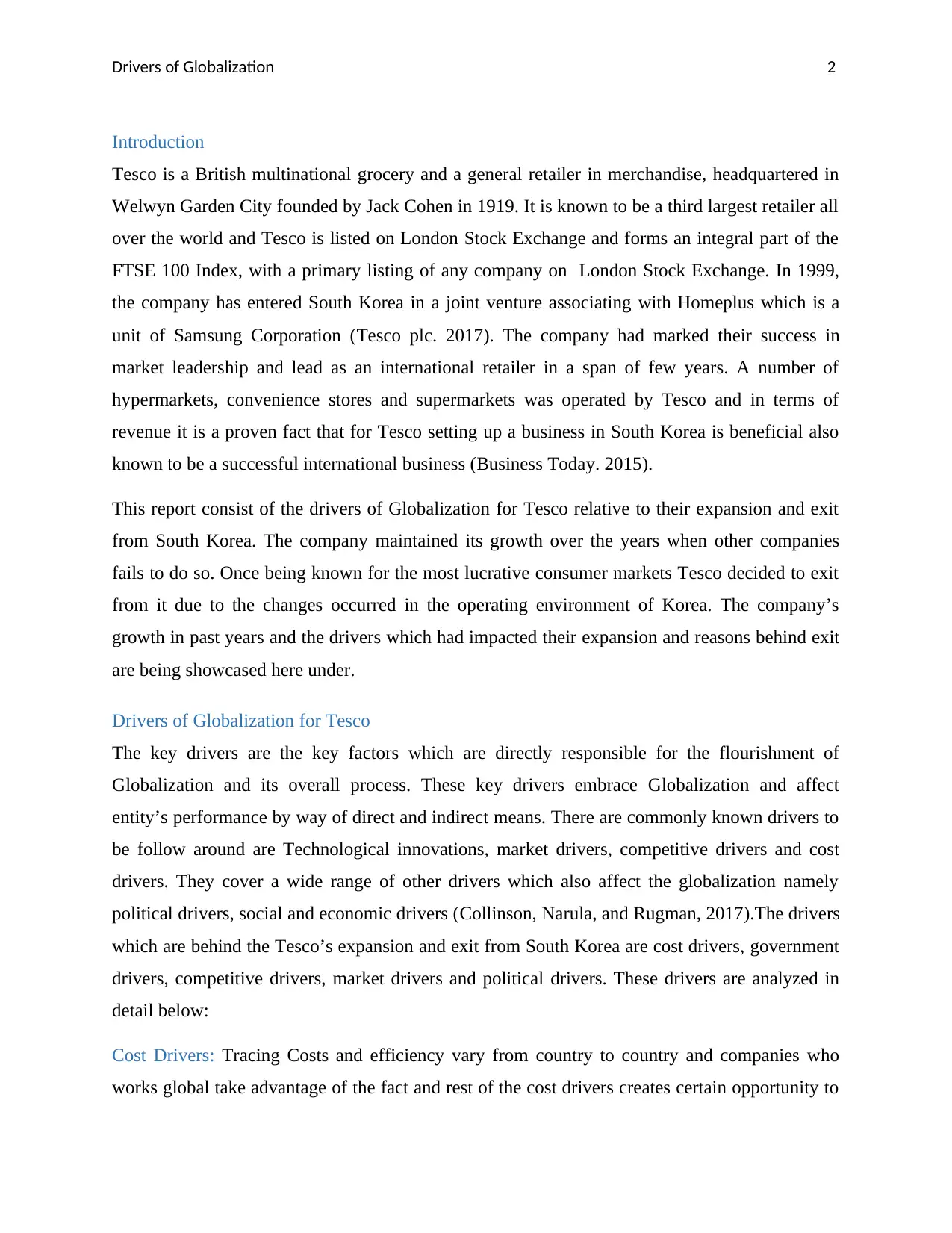
Drivers of Globalization 2
Introduction
Tesco is a British multinational grocery and a general retailer in merchandise, headquartered in
Welwyn Garden City founded by Jack Cohen in 1919. It is known to be a third largest retailer all
over the world and Tesco is listed on London Stock Exchange and forms an integral part of the
FTSE 100 Index, with a primary listing of any company on London Stock Exchange. In 1999,
the company has entered South Korea in a joint venture associating with Homeplus which is a
unit of Samsung Corporation (Tesco plc. 2017). The company had marked their success in
market leadership and lead as an international retailer in a span of few years. A number of
hypermarkets, convenience stores and supermarkets was operated by Tesco and in terms of
revenue it is a proven fact that for Tesco setting up a business in South Korea is beneficial also
known to be a successful international business (Business Today. 2015).
This report consist of the drivers of Globalization for Tesco relative to their expansion and exit
from South Korea. The company maintained its growth over the years when other companies
fails to do so. Once being known for the most lucrative consumer markets Tesco decided to exit
from it due to the changes occurred in the operating environment of Korea. The company’s
growth in past years and the drivers which had impacted their expansion and reasons behind exit
are being showcased here under.
Drivers of Globalization for Tesco
The key drivers are the key factors which are directly responsible for the flourishment of
Globalization and its overall process. These key drivers embrace Globalization and affect
entity’s performance by way of direct and indirect means. There are commonly known drivers to
be follow around are Technological innovations, market drivers, competitive drivers and cost
drivers. They cover a wide range of other drivers which also affect the globalization namely
political drivers, social and economic drivers (Collinson, Narula, and Rugman, 2017).The drivers
which are behind the Tesco’s expansion and exit from South Korea are cost drivers, government
drivers, competitive drivers, market drivers and political drivers. These drivers are analyzed in
detail below:
Cost Drivers: Tracing Costs and efficiency vary from country to country and companies who
works global take advantage of the fact and rest of the cost drivers creates certain opportunity to
Introduction
Tesco is a British multinational grocery and a general retailer in merchandise, headquartered in
Welwyn Garden City founded by Jack Cohen in 1919. It is known to be a third largest retailer all
over the world and Tesco is listed on London Stock Exchange and forms an integral part of the
FTSE 100 Index, with a primary listing of any company on London Stock Exchange. In 1999,
the company has entered South Korea in a joint venture associating with Homeplus which is a
unit of Samsung Corporation (Tesco plc. 2017). The company had marked their success in
market leadership and lead as an international retailer in a span of few years. A number of
hypermarkets, convenience stores and supermarkets was operated by Tesco and in terms of
revenue it is a proven fact that for Tesco setting up a business in South Korea is beneficial also
known to be a successful international business (Business Today. 2015).
This report consist of the drivers of Globalization for Tesco relative to their expansion and exit
from South Korea. The company maintained its growth over the years when other companies
fails to do so. Once being known for the most lucrative consumer markets Tesco decided to exit
from it due to the changes occurred in the operating environment of Korea. The company’s
growth in past years and the drivers which had impacted their expansion and reasons behind exit
are being showcased here under.
Drivers of Globalization for Tesco
The key drivers are the key factors which are directly responsible for the flourishment of
Globalization and its overall process. These key drivers embrace Globalization and affect
entity’s performance by way of direct and indirect means. There are commonly known drivers to
be follow around are Technological innovations, market drivers, competitive drivers and cost
drivers. They cover a wide range of other drivers which also affect the globalization namely
political drivers, social and economic drivers (Collinson, Narula, and Rugman, 2017).The drivers
which are behind the Tesco’s expansion and exit from South Korea are cost drivers, government
drivers, competitive drivers, market drivers and political drivers. These drivers are analyzed in
detail below:
Cost Drivers: Tracing Costs and efficiency vary from country to country and companies who
works global take advantage of the fact and rest of the cost drivers creates certain opportunity to
⊘ This is a preview!⊘
Do you want full access?
Subscribe today to unlock all pages.

Trusted by 1+ million students worldwide
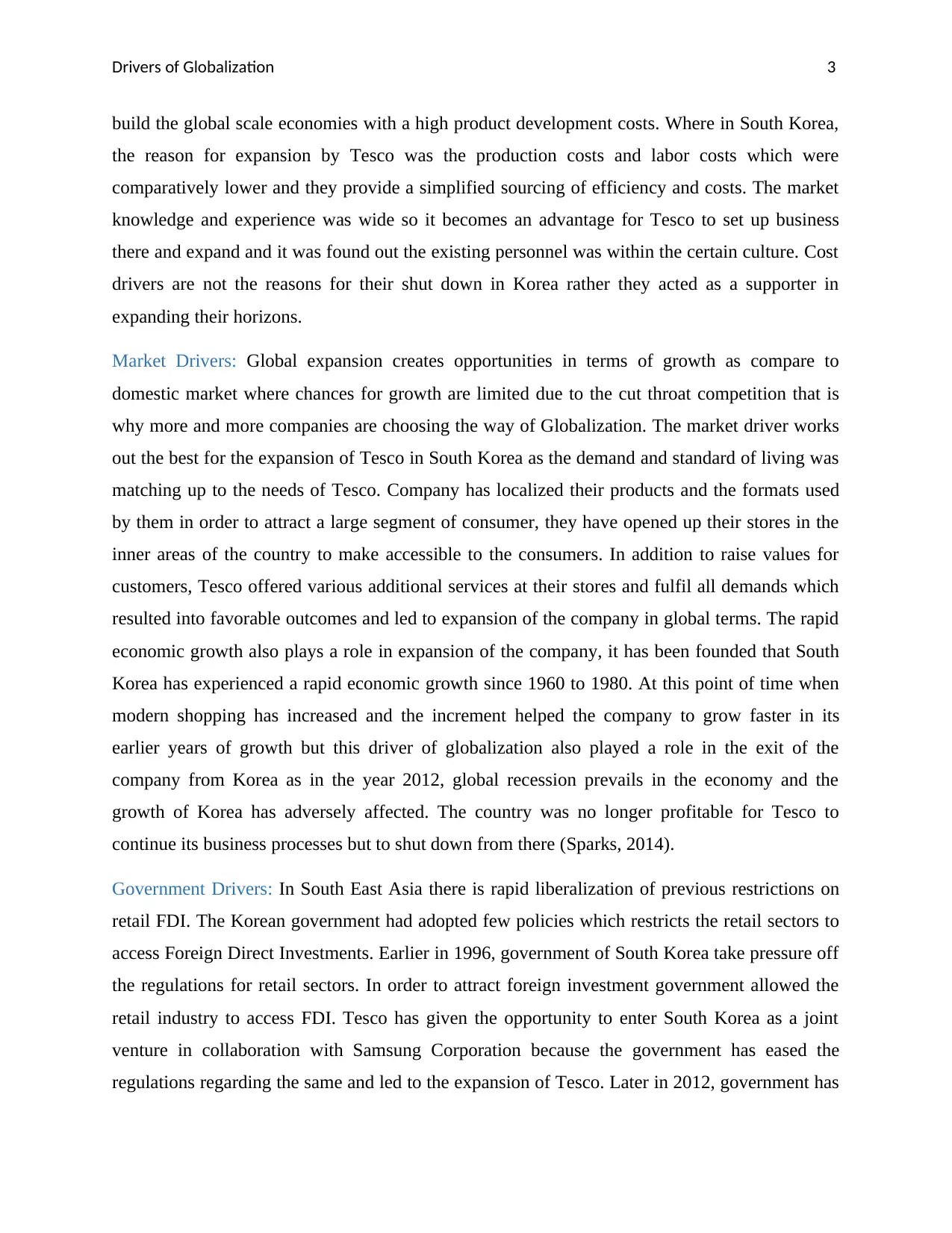
Drivers of Globalization 3
build the global scale economies with a high product development costs. Where in South Korea,
the reason for expansion by Tesco was the production costs and labor costs which were
comparatively lower and they provide a simplified sourcing of efficiency and costs. The market
knowledge and experience was wide so it becomes an advantage for Tesco to set up business
there and expand and it was found out the existing personnel was within the certain culture. Cost
drivers are not the reasons for their shut down in Korea rather they acted as a supporter in
expanding their horizons.
Market Drivers: Global expansion creates opportunities in terms of growth as compare to
domestic market where chances for growth are limited due to the cut throat competition that is
why more and more companies are choosing the way of Globalization. The market driver works
out the best for the expansion of Tesco in South Korea as the demand and standard of living was
matching up to the needs of Tesco. Company has localized their products and the formats used
by them in order to attract a large segment of consumer, they have opened up their stores in the
inner areas of the country to make accessible to the consumers. In addition to raise values for
customers, Tesco offered various additional services at their stores and fulfil all demands which
resulted into favorable outcomes and led to expansion of the company in global terms. The rapid
economic growth also plays a role in expansion of the company, it has been founded that South
Korea has experienced a rapid economic growth since 1960 to 1980. At this point of time when
modern shopping has increased and the increment helped the company to grow faster in its
earlier years of growth but this driver of globalization also played a role in the exit of the
company from Korea as in the year 2012, global recession prevails in the economy and the
growth of Korea has adversely affected. The country was no longer profitable for Tesco to
continue its business processes but to shut down from there (Sparks, 2014).
Government Drivers: In South East Asia there is rapid liberalization of previous restrictions on
retail FDI. The Korean government had adopted few policies which restricts the retail sectors to
access Foreign Direct Investments. Earlier in 1996, government of South Korea take pressure off
the regulations for retail sectors. In order to attract foreign investment government allowed the
retail industry to access FDI. Tesco has given the opportunity to enter South Korea as a joint
venture in collaboration with Samsung Corporation because the government has eased the
regulations regarding the same and led to the expansion of Tesco. Later in 2012, government has
build the global scale economies with a high product development costs. Where in South Korea,
the reason for expansion by Tesco was the production costs and labor costs which were
comparatively lower and they provide a simplified sourcing of efficiency and costs. The market
knowledge and experience was wide so it becomes an advantage for Tesco to set up business
there and expand and it was found out the existing personnel was within the certain culture. Cost
drivers are not the reasons for their shut down in Korea rather they acted as a supporter in
expanding their horizons.
Market Drivers: Global expansion creates opportunities in terms of growth as compare to
domestic market where chances for growth are limited due to the cut throat competition that is
why more and more companies are choosing the way of Globalization. The market driver works
out the best for the expansion of Tesco in South Korea as the demand and standard of living was
matching up to the needs of Tesco. Company has localized their products and the formats used
by them in order to attract a large segment of consumer, they have opened up their stores in the
inner areas of the country to make accessible to the consumers. In addition to raise values for
customers, Tesco offered various additional services at their stores and fulfil all demands which
resulted into favorable outcomes and led to expansion of the company in global terms. The rapid
economic growth also plays a role in expansion of the company, it has been founded that South
Korea has experienced a rapid economic growth since 1960 to 1980. At this point of time when
modern shopping has increased and the increment helped the company to grow faster in its
earlier years of growth but this driver of globalization also played a role in the exit of the
company from Korea as in the year 2012, global recession prevails in the economy and the
growth of Korea has adversely affected. The country was no longer profitable for Tesco to
continue its business processes but to shut down from there (Sparks, 2014).
Government Drivers: In South East Asia there is rapid liberalization of previous restrictions on
retail FDI. The Korean government had adopted few policies which restricts the retail sectors to
access Foreign Direct Investments. Earlier in 1996, government of South Korea take pressure off
the regulations for retail sectors. In order to attract foreign investment government allowed the
retail industry to access FDI. Tesco has given the opportunity to enter South Korea as a joint
venture in collaboration with Samsung Corporation because the government has eased the
regulations regarding the same and led to the expansion of Tesco. Later in 2012, government has
Paraphrase This Document
Need a fresh take? Get an instant paraphrase of this document with our AI Paraphraser
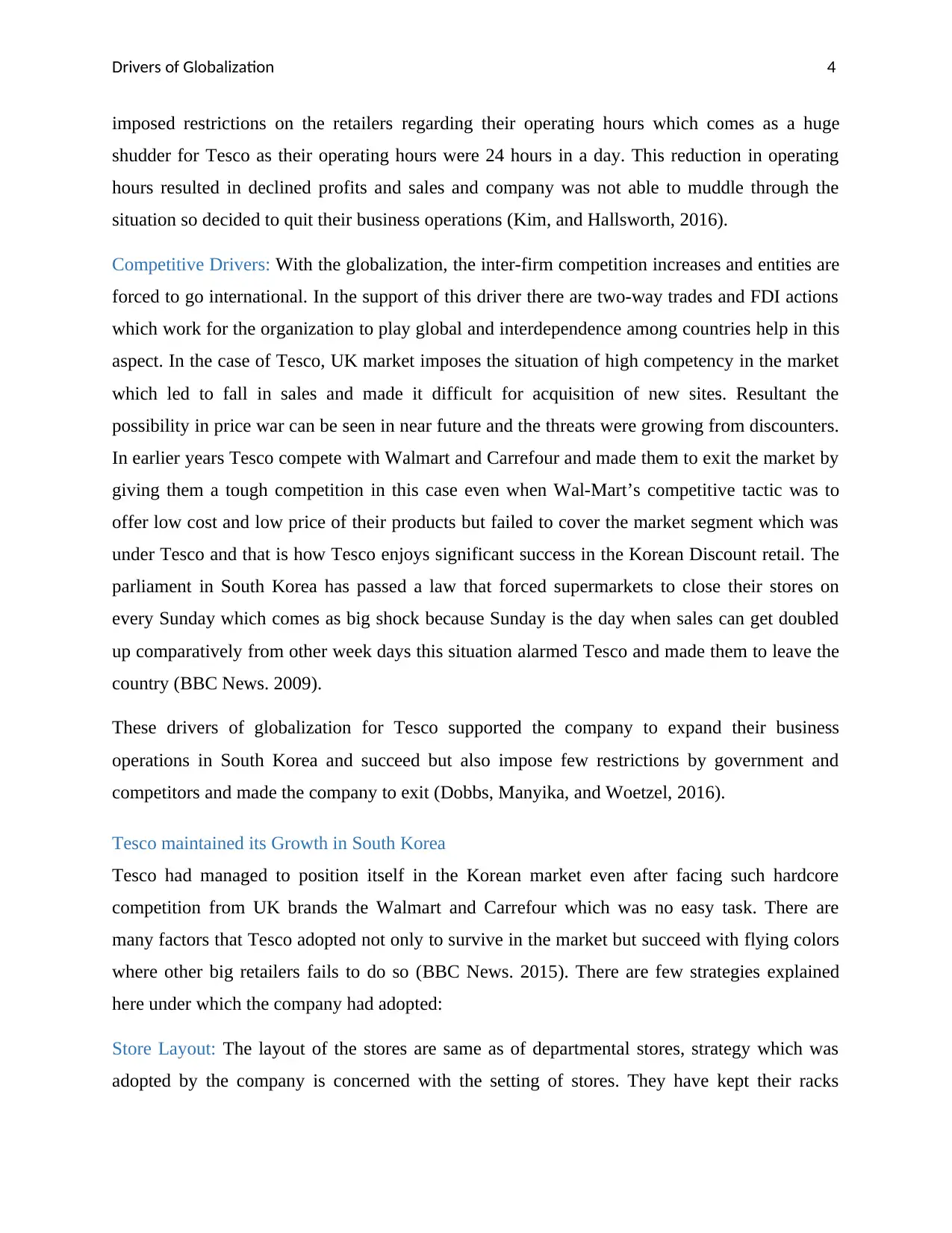
Drivers of Globalization 4
imposed restrictions on the retailers regarding their operating hours which comes as a huge
shudder for Tesco as their operating hours were 24 hours in a day. This reduction in operating
hours resulted in declined profits and sales and company was not able to muddle through the
situation so decided to quit their business operations (Kim, and Hallsworth, 2016).
Competitive Drivers: With the globalization, the inter-firm competition increases and entities are
forced to go international. In the support of this driver there are two-way trades and FDI actions
which work for the organization to play global and interdependence among countries help in this
aspect. In the case of Tesco, UK market imposes the situation of high competency in the market
which led to fall in sales and made it difficult for acquisition of new sites. Resultant the
possibility in price war can be seen in near future and the threats were growing from discounters.
In earlier years Tesco compete with Walmart and Carrefour and made them to exit the market by
giving them a tough competition in this case even when Wal-Mart’s competitive tactic was to
offer low cost and low price of their products but failed to cover the market segment which was
under Tesco and that is how Tesco enjoys significant success in the Korean Discount retail. The
parliament in South Korea has passed a law that forced supermarkets to close their stores on
every Sunday which comes as big shock because Sunday is the day when sales can get doubled
up comparatively from other week days this situation alarmed Tesco and made them to leave the
country (BBC News. 2009).
These drivers of globalization for Tesco supported the company to expand their business
operations in South Korea and succeed but also impose few restrictions by government and
competitors and made the company to exit (Dobbs, Manyika, and Woetzel, 2016).
Tesco maintained its Growth in South Korea
Tesco had managed to position itself in the Korean market even after facing such hardcore
competition from UK brands the Walmart and Carrefour which was no easy task. There are
many factors that Tesco adopted not only to survive in the market but succeed with flying colors
where other big retailers fails to do so (BBC News. 2015). There are few strategies explained
here under which the company had adopted:
Store Layout: The layout of the stores are same as of departmental stores, strategy which was
adopted by the company is concerned with the setting of stores. They have kept their racks
imposed restrictions on the retailers regarding their operating hours which comes as a huge
shudder for Tesco as their operating hours were 24 hours in a day. This reduction in operating
hours resulted in declined profits and sales and company was not able to muddle through the
situation so decided to quit their business operations (Kim, and Hallsworth, 2016).
Competitive Drivers: With the globalization, the inter-firm competition increases and entities are
forced to go international. In the support of this driver there are two-way trades and FDI actions
which work for the organization to play global and interdependence among countries help in this
aspect. In the case of Tesco, UK market imposes the situation of high competency in the market
which led to fall in sales and made it difficult for acquisition of new sites. Resultant the
possibility in price war can be seen in near future and the threats were growing from discounters.
In earlier years Tesco compete with Walmart and Carrefour and made them to exit the market by
giving them a tough competition in this case even when Wal-Mart’s competitive tactic was to
offer low cost and low price of their products but failed to cover the market segment which was
under Tesco and that is how Tesco enjoys significant success in the Korean Discount retail. The
parliament in South Korea has passed a law that forced supermarkets to close their stores on
every Sunday which comes as big shock because Sunday is the day when sales can get doubled
up comparatively from other week days this situation alarmed Tesco and made them to leave the
country (BBC News. 2009).
These drivers of globalization for Tesco supported the company to expand their business
operations in South Korea and succeed but also impose few restrictions by government and
competitors and made the company to exit (Dobbs, Manyika, and Woetzel, 2016).
Tesco maintained its Growth in South Korea
Tesco had managed to position itself in the Korean market even after facing such hardcore
competition from UK brands the Walmart and Carrefour which was no easy task. There are
many factors that Tesco adopted not only to survive in the market but succeed with flying colors
where other big retailers fails to do so (BBC News. 2015). There are few strategies explained
here under which the company had adopted:
Store Layout: The layout of the stores are same as of departmental stores, strategy which was
adopted by the company is concerned with the setting of stores. They have kept their racks
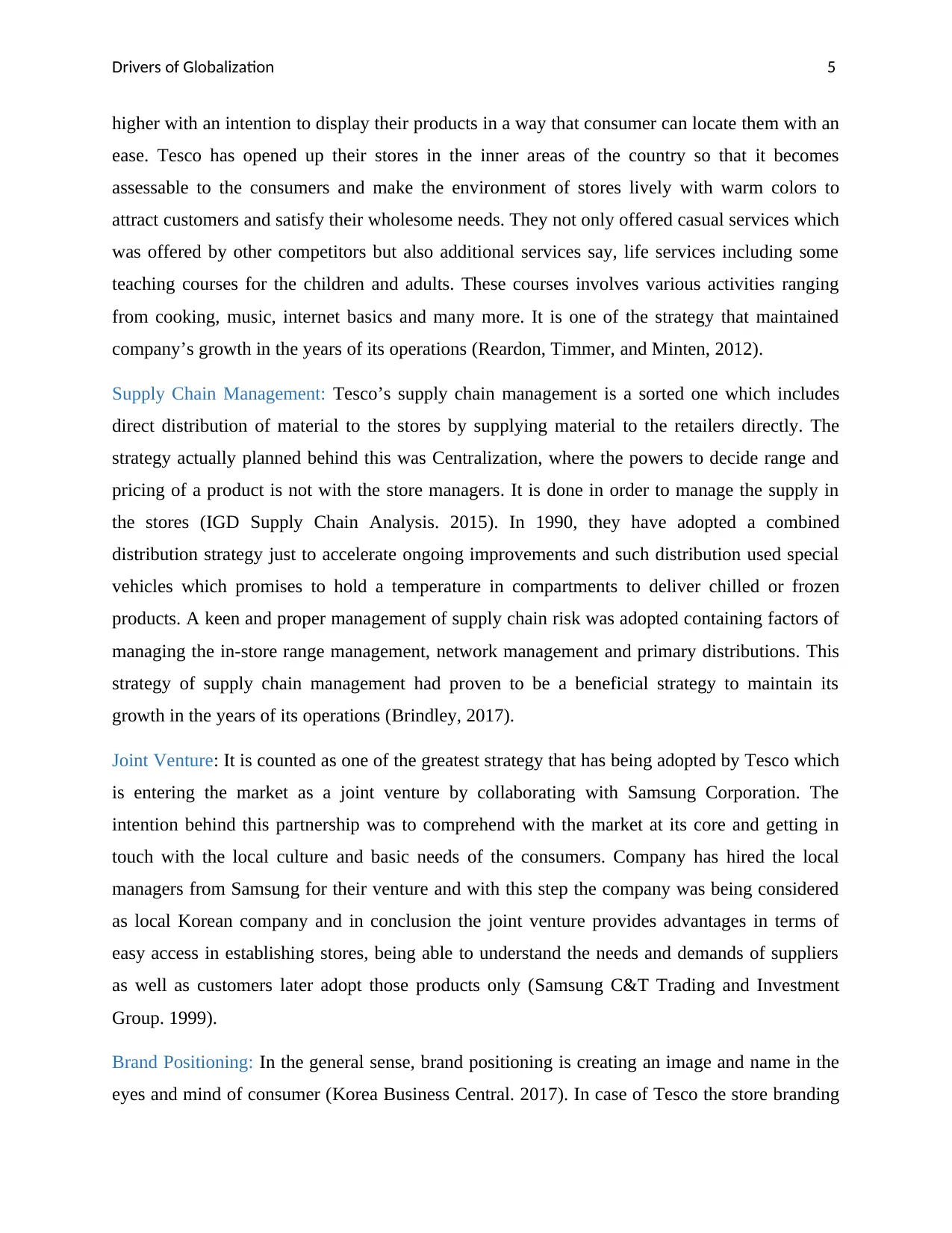
Drivers of Globalization 5
higher with an intention to display their products in a way that consumer can locate them with an
ease. Tesco has opened up their stores in the inner areas of the country so that it becomes
assessable to the consumers and make the environment of stores lively with warm colors to
attract customers and satisfy their wholesome needs. They not only offered casual services which
was offered by other competitors but also additional services say, life services including some
teaching courses for the children and adults. These courses involves various activities ranging
from cooking, music, internet basics and many more. It is one of the strategy that maintained
company’s growth in the years of its operations (Reardon, Timmer, and Minten, 2012).
Supply Chain Management: Tesco’s supply chain management is a sorted one which includes
direct distribution of material to the stores by supplying material to the retailers directly. The
strategy actually planned behind this was Centralization, where the powers to decide range and
pricing of a product is not with the store managers. It is done in order to manage the supply in
the stores (IGD Supply Chain Analysis. 2015). In 1990, they have adopted a combined
distribution strategy just to accelerate ongoing improvements and such distribution used special
vehicles which promises to hold a temperature in compartments to deliver chilled or frozen
products. A keen and proper management of supply chain risk was adopted containing factors of
managing the in-store range management, network management and primary distributions. This
strategy of supply chain management had proven to be a beneficial strategy to maintain its
growth in the years of its operations (Brindley, 2017).
Joint Venture: It is counted as one of the greatest strategy that has being adopted by Tesco which
is entering the market as a joint venture by collaborating with Samsung Corporation. The
intention behind this partnership was to comprehend with the market at its core and getting in
touch with the local culture and basic needs of the consumers. Company has hired the local
managers from Samsung for their venture and with this step the company was being considered
as local Korean company and in conclusion the joint venture provides advantages in terms of
easy access in establishing stores, being able to understand the needs and demands of suppliers
as well as customers later adopt those products only (Samsung C&T Trading and Investment
Group. 1999).
Brand Positioning: In the general sense, brand positioning is creating an image and name in the
eyes and mind of consumer (Korea Business Central. 2017). In case of Tesco the store branding
higher with an intention to display their products in a way that consumer can locate them with an
ease. Tesco has opened up their stores in the inner areas of the country so that it becomes
assessable to the consumers and make the environment of stores lively with warm colors to
attract customers and satisfy their wholesome needs. They not only offered casual services which
was offered by other competitors but also additional services say, life services including some
teaching courses for the children and adults. These courses involves various activities ranging
from cooking, music, internet basics and many more. It is one of the strategy that maintained
company’s growth in the years of its operations (Reardon, Timmer, and Minten, 2012).
Supply Chain Management: Tesco’s supply chain management is a sorted one which includes
direct distribution of material to the stores by supplying material to the retailers directly. The
strategy actually planned behind this was Centralization, where the powers to decide range and
pricing of a product is not with the store managers. It is done in order to manage the supply in
the stores (IGD Supply Chain Analysis. 2015). In 1990, they have adopted a combined
distribution strategy just to accelerate ongoing improvements and such distribution used special
vehicles which promises to hold a temperature in compartments to deliver chilled or frozen
products. A keen and proper management of supply chain risk was adopted containing factors of
managing the in-store range management, network management and primary distributions. This
strategy of supply chain management had proven to be a beneficial strategy to maintain its
growth in the years of its operations (Brindley, 2017).
Joint Venture: It is counted as one of the greatest strategy that has being adopted by Tesco which
is entering the market as a joint venture by collaborating with Samsung Corporation. The
intention behind this partnership was to comprehend with the market at its core and getting in
touch with the local culture and basic needs of the consumers. Company has hired the local
managers from Samsung for their venture and with this step the company was being considered
as local Korean company and in conclusion the joint venture provides advantages in terms of
easy access in establishing stores, being able to understand the needs and demands of suppliers
as well as customers later adopt those products only (Samsung C&T Trading and Investment
Group. 1999).
Brand Positioning: In the general sense, brand positioning is creating an image and name in the
eyes and mind of consumer (Korea Business Central. 2017). In case of Tesco the store branding
⊘ This is a preview!⊘
Do you want full access?
Subscribe today to unlock all pages.

Trusted by 1+ million students worldwide
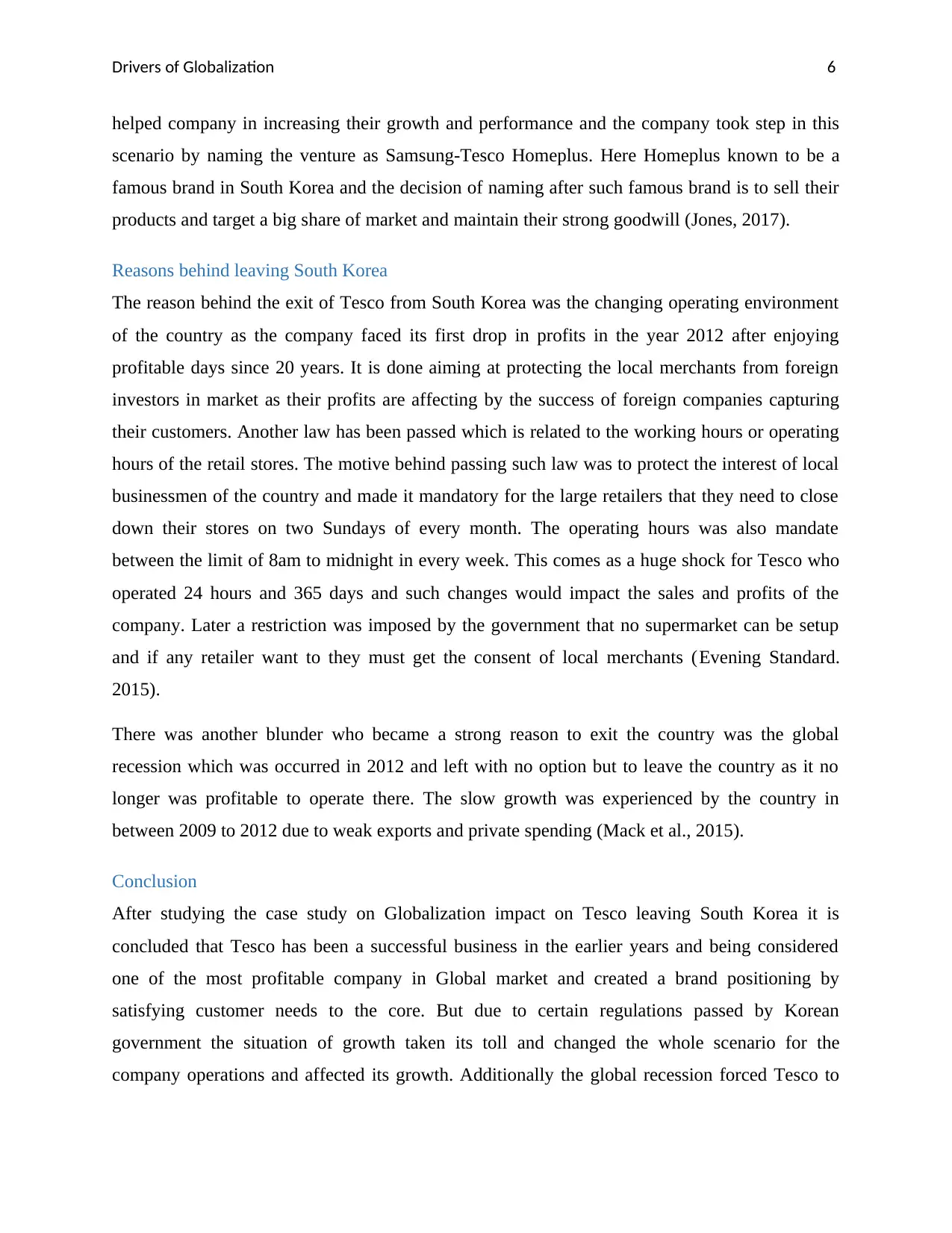
Drivers of Globalization 6
helped company in increasing their growth and performance and the company took step in this
scenario by naming the venture as Samsung-Tesco Homeplus. Here Homeplus known to be a
famous brand in South Korea and the decision of naming after such famous brand is to sell their
products and target a big share of market and maintain their strong goodwill (Jones, 2017).
Reasons behind leaving South Korea
The reason behind the exit of Tesco from South Korea was the changing operating environment
of the country as the company faced its first drop in profits in the year 2012 after enjoying
profitable days since 20 years. It is done aiming at protecting the local merchants from foreign
investors in market as their profits are affecting by the success of foreign companies capturing
their customers. Another law has been passed which is related to the working hours or operating
hours of the retail stores. The motive behind passing such law was to protect the interest of local
businessmen of the country and made it mandatory for the large retailers that they need to close
down their stores on two Sundays of every month. The operating hours was also mandate
between the limit of 8am to midnight in every week. This comes as a huge shock for Tesco who
operated 24 hours and 365 days and such changes would impact the sales and profits of the
company. Later a restriction was imposed by the government that no supermarket can be setup
and if any retailer want to they must get the consent of local merchants (Evening Standard.
2015).
There was another blunder who became a strong reason to exit the country was the global
recession which was occurred in 2012 and left with no option but to leave the country as it no
longer was profitable to operate there. The slow growth was experienced by the country in
between 2009 to 2012 due to weak exports and private spending (Mack et al., 2015).
Conclusion
After studying the case study on Globalization impact on Tesco leaving South Korea it is
concluded that Tesco has been a successful business in the earlier years and being considered
one of the most profitable company in Global market and created a brand positioning by
satisfying customer needs to the core. But due to certain regulations passed by Korean
government the situation of growth taken its toll and changed the whole scenario for the
company operations and affected its growth. Additionally the global recession forced Tesco to
helped company in increasing their growth and performance and the company took step in this
scenario by naming the venture as Samsung-Tesco Homeplus. Here Homeplus known to be a
famous brand in South Korea and the decision of naming after such famous brand is to sell their
products and target a big share of market and maintain their strong goodwill (Jones, 2017).
Reasons behind leaving South Korea
The reason behind the exit of Tesco from South Korea was the changing operating environment
of the country as the company faced its first drop in profits in the year 2012 after enjoying
profitable days since 20 years. It is done aiming at protecting the local merchants from foreign
investors in market as their profits are affecting by the success of foreign companies capturing
their customers. Another law has been passed which is related to the working hours or operating
hours of the retail stores. The motive behind passing such law was to protect the interest of local
businessmen of the country and made it mandatory for the large retailers that they need to close
down their stores on two Sundays of every month. The operating hours was also mandate
between the limit of 8am to midnight in every week. This comes as a huge shock for Tesco who
operated 24 hours and 365 days and such changes would impact the sales and profits of the
company. Later a restriction was imposed by the government that no supermarket can be setup
and if any retailer want to they must get the consent of local merchants (Evening Standard.
2015).
There was another blunder who became a strong reason to exit the country was the global
recession which was occurred in 2012 and left with no option but to leave the country as it no
longer was profitable to operate there. The slow growth was experienced by the country in
between 2009 to 2012 due to weak exports and private spending (Mack et al., 2015).
Conclusion
After studying the case study on Globalization impact on Tesco leaving South Korea it is
concluded that Tesco has been a successful business in the earlier years and being considered
one of the most profitable company in Global market and created a brand positioning by
satisfying customer needs to the core. But due to certain regulations passed by Korean
government the situation of growth taken its toll and changed the whole scenario for the
company operations and affected its growth. Additionally the global recession forced Tesco to
Paraphrase This Document
Need a fresh take? Get an instant paraphrase of this document with our AI Paraphraser
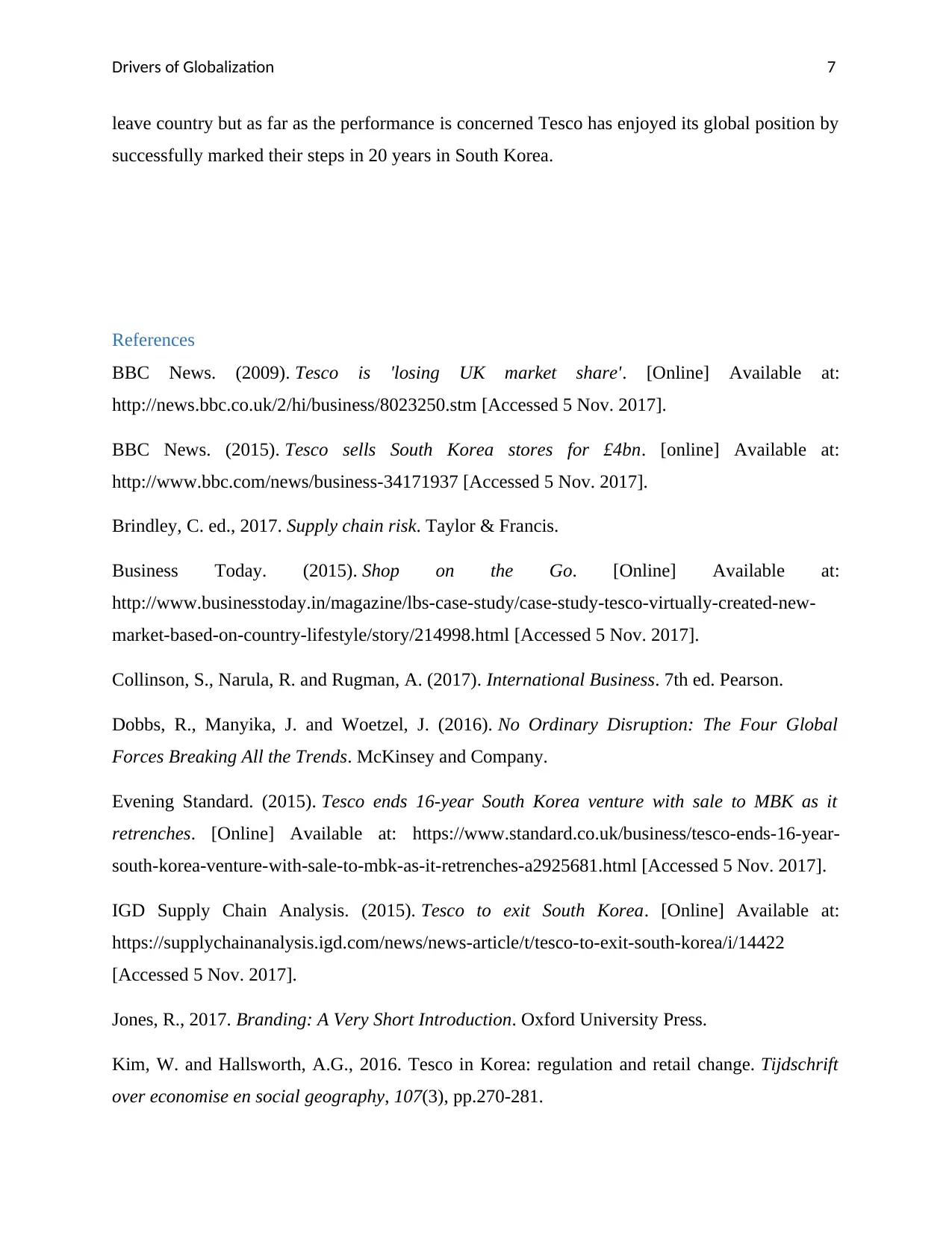
Drivers of Globalization 7
leave country but as far as the performance is concerned Tesco has enjoyed its global position by
successfully marked their steps in 20 years in South Korea.
References
BBC News. (2009). Tesco is 'losing UK market share'. [Online] Available at:
http://news.bbc.co.uk/2/hi/business/8023250.stm [Accessed 5 Nov. 2017].
BBC News. (2015). Tesco sells South Korea stores for £4bn. [online] Available at:
http://www.bbc.com/news/business-34171937 [Accessed 5 Nov. 2017].
Brindley, C. ed., 2017. Supply chain risk. Taylor & Francis.
Business Today. (2015). Shop on the Go. [Online] Available at:
http://www.businesstoday.in/magazine/lbs-case-study/case-study-tesco-virtually-created-new-
market-based-on-country-lifestyle/story/214998.html [Accessed 5 Nov. 2017].
Collinson, S., Narula, R. and Rugman, A. (2017). International Business. 7th ed. Pearson.
Dobbs, R., Manyika, J. and Woetzel, J. (2016). No Ordinary Disruption: The Four Global
Forces Breaking All the Trends. McKinsey and Company.
Evening Standard. (2015). Tesco ends 16-year South Korea venture with sale to MBK as it
retrenches. [Online] Available at: https://www.standard.co.uk/business/tesco-ends-16-year-
south-korea-venture-with-sale-to-mbk-as-it-retrenches-a2925681.html [Accessed 5 Nov. 2017].
IGD Supply Chain Analysis. (2015). Tesco to exit South Korea. [Online] Available at:
https://supplychainanalysis.igd.com/news/news-article/t/tesco-to-exit-south-korea/i/14422
[Accessed 5 Nov. 2017].
Jones, R., 2017. Branding: A Very Short Introduction. Oxford University Press.
Kim, W. and Hallsworth, A.G., 2016. Tesco in Korea: regulation and retail change. Tijdschrift
over economise en social geography, 107(3), pp.270-281.
leave country but as far as the performance is concerned Tesco has enjoyed its global position by
successfully marked their steps in 20 years in South Korea.
References
BBC News. (2009). Tesco is 'losing UK market share'. [Online] Available at:
http://news.bbc.co.uk/2/hi/business/8023250.stm [Accessed 5 Nov. 2017].
BBC News. (2015). Tesco sells South Korea stores for £4bn. [online] Available at:
http://www.bbc.com/news/business-34171937 [Accessed 5 Nov. 2017].
Brindley, C. ed., 2017. Supply chain risk. Taylor & Francis.
Business Today. (2015). Shop on the Go. [Online] Available at:
http://www.businesstoday.in/magazine/lbs-case-study/case-study-tesco-virtually-created-new-
market-based-on-country-lifestyle/story/214998.html [Accessed 5 Nov. 2017].
Collinson, S., Narula, R. and Rugman, A. (2017). International Business. 7th ed. Pearson.
Dobbs, R., Manyika, J. and Woetzel, J. (2016). No Ordinary Disruption: The Four Global
Forces Breaking All the Trends. McKinsey and Company.
Evening Standard. (2015). Tesco ends 16-year South Korea venture with sale to MBK as it
retrenches. [Online] Available at: https://www.standard.co.uk/business/tesco-ends-16-year-
south-korea-venture-with-sale-to-mbk-as-it-retrenches-a2925681.html [Accessed 5 Nov. 2017].
IGD Supply Chain Analysis. (2015). Tesco to exit South Korea. [Online] Available at:
https://supplychainanalysis.igd.com/news/news-article/t/tesco-to-exit-south-korea/i/14422
[Accessed 5 Nov. 2017].
Jones, R., 2017. Branding: A Very Short Introduction. Oxford University Press.
Kim, W. and Hallsworth, A.G., 2016. Tesco in Korea: regulation and retail change. Tijdschrift
over economise en social geography, 107(3), pp.270-281.
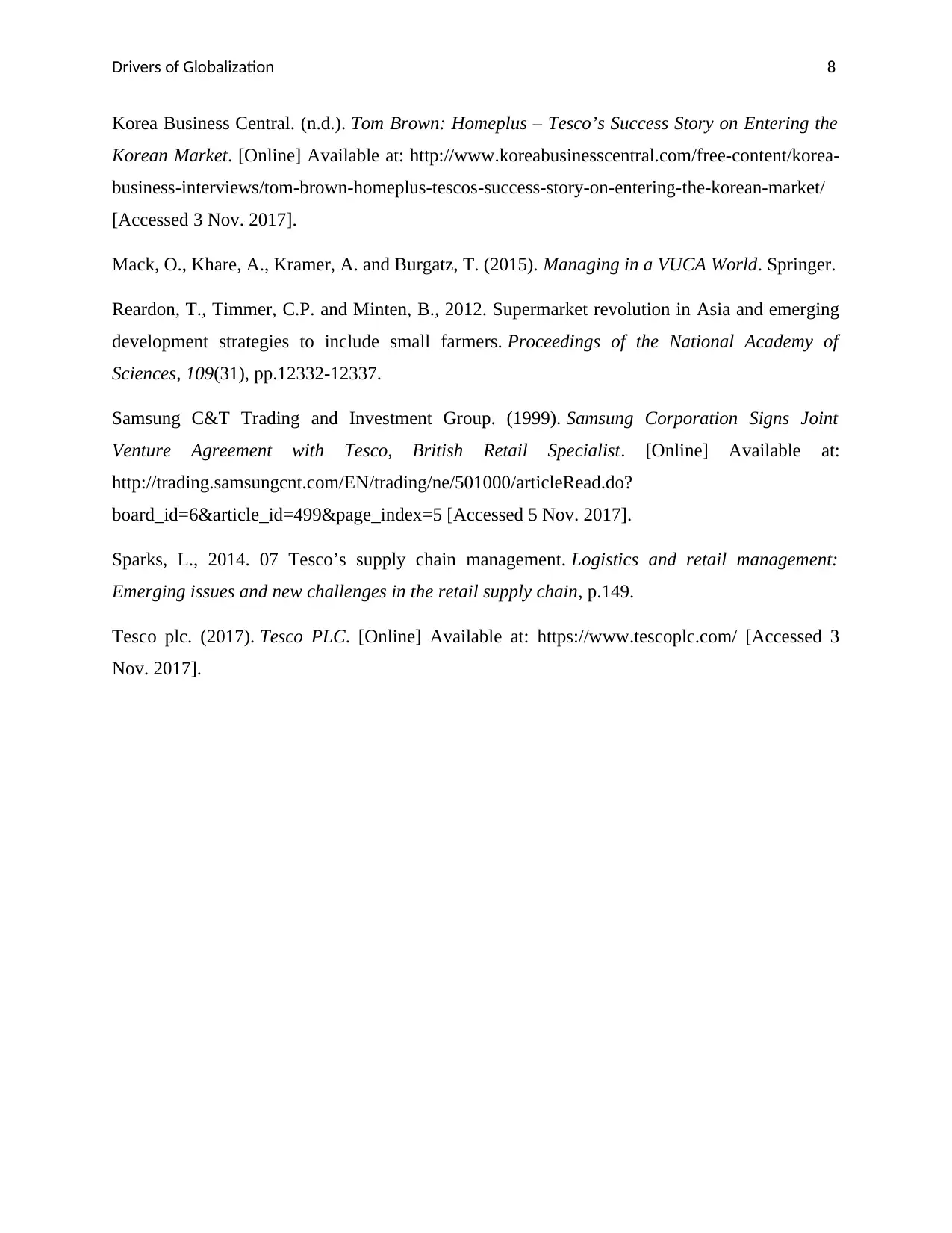
Drivers of Globalization 8
Korea Business Central. (n.d.). Tom Brown: Homeplus – Tesco’s Success Story on Entering the
Korean Market. [Online] Available at: http://www.koreabusinesscentral.com/free-content/korea-
business-interviews/tom-brown-homeplus-tescos-success-story-on-entering-the-korean-market/
[Accessed 3 Nov. 2017].
Mack, O., Khare, A., Kramer, A. and Burgatz, T. (2015). Managing in a VUCA World. Springer.
Reardon, T., Timmer, C.P. and Minten, B., 2012. Supermarket revolution in Asia and emerging
development strategies to include small farmers. Proceedings of the National Academy of
Sciences, 109(31), pp.12332-12337.
Samsung C&T Trading and Investment Group. (1999). Samsung Corporation Signs Joint
Venture Agreement with Tesco, British Retail Specialist. [Online] Available at:
http://trading.samsungcnt.com/EN/trading/ne/501000/articleRead.do?
board_id=6&article_id=499&page_index=5 [Accessed 5 Nov. 2017].
Sparks, L., 2014. 07 Tesco’s supply chain management. Logistics and retail management:
Emerging issues and new challenges in the retail supply chain, p.149.
Tesco plc. (2017). Tesco PLC. [Online] Available at: https://www.tescoplc.com/ [Accessed 3
Nov. 2017].
Korea Business Central. (n.d.). Tom Brown: Homeplus – Tesco’s Success Story on Entering the
Korean Market. [Online] Available at: http://www.koreabusinesscentral.com/free-content/korea-
business-interviews/tom-brown-homeplus-tescos-success-story-on-entering-the-korean-market/
[Accessed 3 Nov. 2017].
Mack, O., Khare, A., Kramer, A. and Burgatz, T. (2015). Managing in a VUCA World. Springer.
Reardon, T., Timmer, C.P. and Minten, B., 2012. Supermarket revolution in Asia and emerging
development strategies to include small farmers. Proceedings of the National Academy of
Sciences, 109(31), pp.12332-12337.
Samsung C&T Trading and Investment Group. (1999). Samsung Corporation Signs Joint
Venture Agreement with Tesco, British Retail Specialist. [Online] Available at:
http://trading.samsungcnt.com/EN/trading/ne/501000/articleRead.do?
board_id=6&article_id=499&page_index=5 [Accessed 5 Nov. 2017].
Sparks, L., 2014. 07 Tesco’s supply chain management. Logistics and retail management:
Emerging issues and new challenges in the retail supply chain, p.149.
Tesco plc. (2017). Tesco PLC. [Online] Available at: https://www.tescoplc.com/ [Accessed 3
Nov. 2017].
⊘ This is a preview!⊘
Do you want full access?
Subscribe today to unlock all pages.

Trusted by 1+ million students worldwide
1 out of 9
Related Documents
Your All-in-One AI-Powered Toolkit for Academic Success.
+13062052269
info@desklib.com
Available 24*7 on WhatsApp / Email
![[object Object]](/_next/static/media/star-bottom.7253800d.svg)
Unlock your academic potential
Copyright © 2020–2025 A2Z Services. All Rights Reserved. Developed and managed by ZUCOL.




